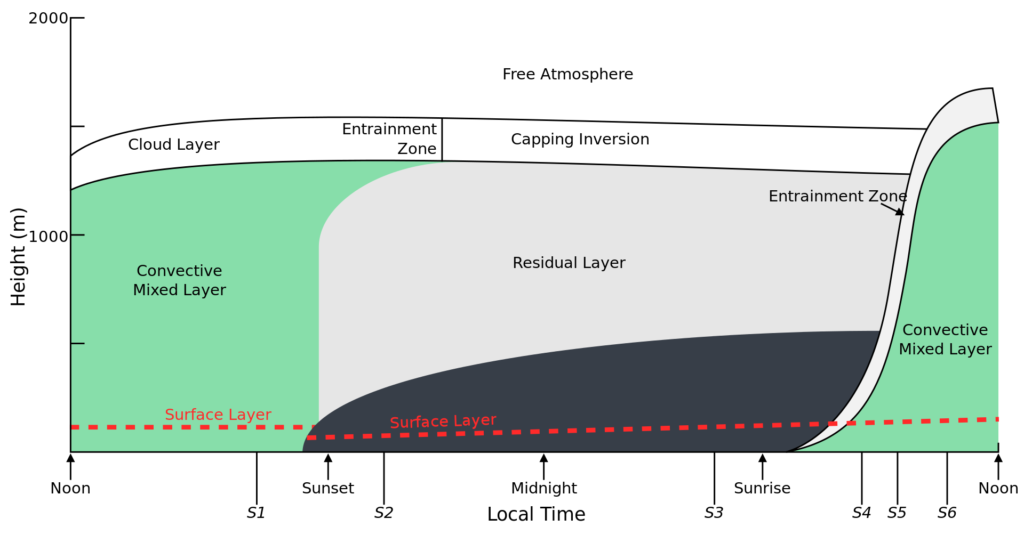Featuring image: northern rim of Gale Crater viewed by Curiosity. NASA/JPL-Caltech/MSSS, public domain (CC0)
Paper: Day-night differences in Mars methane suggest nighttime containment at Gale crater
Authors: C. R. Webster, P. R. Mahaffy, J. Pla-Garcia, S. C. R. Rafkin, J. E. Moores, S. K. Atreya, G. J. Flesch, C. A. Malespin, S. M. Teinturier, H. Kalucha, C. L. Smith, D. Viúdez-Moreiras and A. R. Vasavada
Methane is a gas often connected to life on Earth. NASA’s Mars rover reported the detection of methane, but discrepancies with other missions puzzled researchers. Is there methane on Mars or not? A new study tries to answer this question in a windy way.
Methane is a possible biosignature for extraterrestrial life and therefore, one of the goals of the Mars rover Curiosity was to search for methane. Curiosity was able to detect varying amounts of this gas over the years, but the existence of methane in the Martian atmosphere could not be confirmed by analysis from satellites. Now, Christopher Webster and his group were able to explain the variations as well as the discrepancy between ground-based and satellite analysis by developing a detailed model of the wind systems at Gale crater.

NASA’s rover Curiosity landed on Mars inside the Gale crater on the 6th of August in 2012. During its exploration of the Martian surface, it regularly measured the methane concentration at Gale crater. Methane is a very interesting molecule useful for the search for life on Mars. A lot of bacteria which feed and survive in environments without oxygen produce it. It is therefore considered as a possible biosignature on planets without an oxygen-rich atmosphere. Thus, scientists constructed Curiosity with a Tunable Laser Spectrometer, also called the TLS-SAM instrument, which allows the rover to analyse the composition of the atmosphere around it. While prior measurements of the Martian atmosphere by satellites and Earth-based instruments were not able to detect methane, Curiosity found low concentrations of it during the night, but measurements during daytime could not confirm the presence of methane. In addition to the variations between day and night, Curiosity also recorded seasonal differences with higher methane concentrations during Mars’ summer and early Autumn.
Where is the methane coming from and why is it disappearing? After a very careful examination of all parts of the rover, Webster’s team excluded the rover itself as a possible source of methane. Because satellites were still not able to detect any methane, the researches turned their attention to the regolith, Mars’ soil. If the methane is produced in very small amounts below the surface, it will accumulate within meters above the ground during the night when low temperatures prevent winds that would carry methane up into the higher atmosphere. But as soon as the temperature rises at dawn, methane can escape into the atmosphere where the low amounts are too small to be detected by satellites or Earth-based observatories. This prevention of atmospheric exchange is called planetary boundary layer.

After coming up with this theory, Webster and his colleagues still had to solve the question of why Curiosity measured lower concentrations, or no methane at all, during the Martian winters. To answer this, they developed a detailed climate model of the area in and around Gale crater. It turned out that the winds in that region are so strong in autumn and winter, that there is a lot of exchange between the atmosphere inside the crater and the neighbouring areas. The methane is quickly transported away from Curiosity and concentrations cannot reach a level high enough to be detected by Curiosity.
Still, the question remains what is producing the methane under the Martian surface? While there is no answer yet, these new results show that Curiosity’s detection of methane is not in contradiction with measurements from other satellites or observatories and that methane is actually actively set free by the soil inside Gale crater. To tell if the source of methane is connected to life, we need to further explore our red neighbour. Luckily a new rover, Perseverance, has just arrived on Mars.
License:
‘Mysterious methane on Mars’ by Max Winkler is licensed under a Creative Commons Attribution-ShareAlike 4.0 International License.

